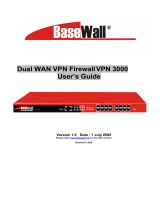
6 Contents
Load balancing ............................................................................................. 51
SMTP binding ............................................................................................... 52
Binding to other protocols ......................................................................... 52
Failover .......................................................................................................... 52
DNS gateway ................................................................................................. 53
Optional network settings .......................................................................... 54
Chapter 4 Configuring internal connections
Configuring LAN IP settings .............................................................................. 57
Configuring the appliance as DHCP server ..................................................... 58
Monitoring DHCP usage ............................................................................. 60
Configuring port assignments ........................................................................... 60
Standard port assignment .......................................................................... 61
Chapter 5 Network traffic control
Planning network access .................................................................................... 63
Understanding computers and computer groups .......................................... 64
Defining computer group membership .................................................... 65
Defining computer groups ......................................................................... 67
Defining inbound access ..................................................................................... 68
Defining outbound access .................................................................................. 69
Configuring services ........................................................................................... 72
Redirecting services .................................................................................... 73
Configuring special applications ....................................................................... 74
Configuring advanced options ........................................................................... 76
Enabling the IDENT port ............................................................................ 76
Disabling NAT mode ................................................................................... 77
Enabling IPsec pass-thru ............................................................................ 77
Configuring an exposed host ..................................................................... 78
Managing ICMP requests ............................................................................ 79
Chapter 6 Establishing secure VPN connections
About using this chapter .................................................................................... 82
Creating security policies ................................................................................... 82
Understanding VPN policies ...................................................................... 82
Creating custom Phase 2 VPN policies ..................................................... 84
Viewing VPN Policies List ..........................................................................85
Identifying users .................................................................................................. 85
Understanding user types ..........................................................................86
Defining users .............................................................................................. 86
Viewing the User List .................................................................................. 88
Configuring Gateway-to-Gateway tunnels ...................................................... 88





















